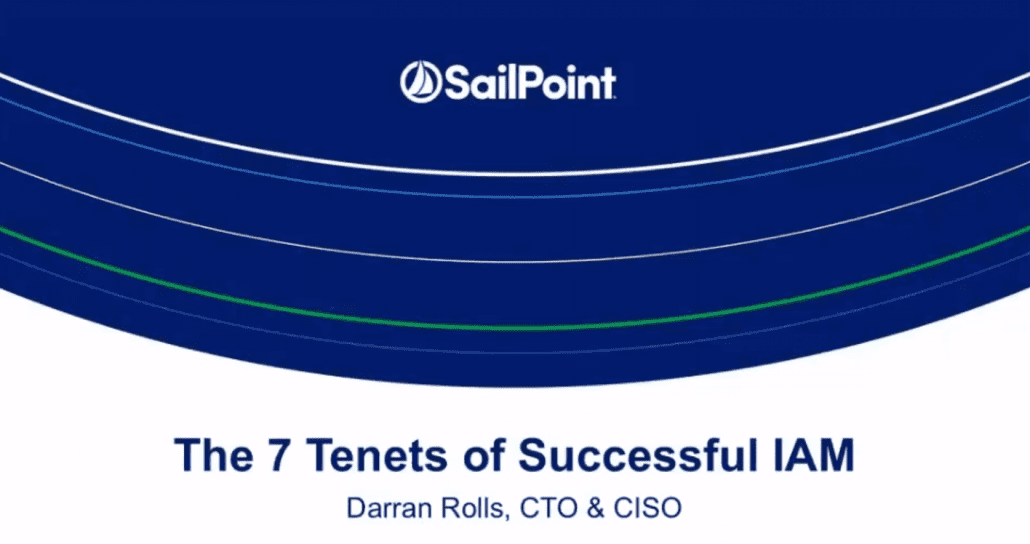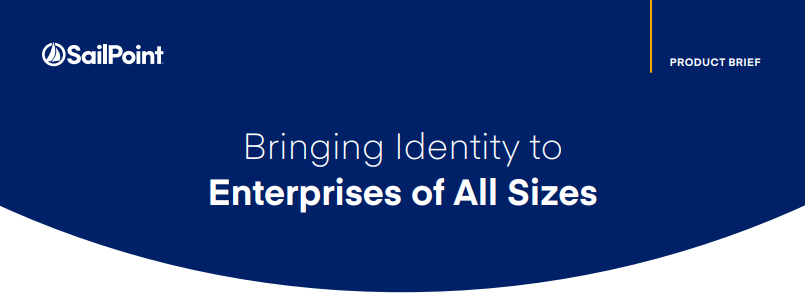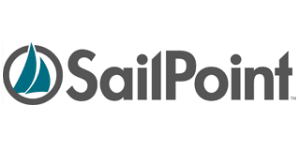7 Tenets of Successful IAM (webinar)

SailPoint CTO and CISO Darran Rolls discusses the seven tenets of a successful IAM program in this informative webinar (59:15)
7 Tenets of Successful IAM (webinar)

SailPoint CTO and CISO Darran Rolls discusses the seven tenets of a successful IAM program in this informative webinar (59:15)
7 Tenets of Successful IAM (webinar)

This digital transformation has had vast implications to the speed of business, but it has also made managing users and resources significantly more complex. Modern business environments are more open and interconnected than ever before. Employees, contractors, suppliers and business partners need to access company resources from a variety of devices and locations.
VIDEO – THE 7 TENETS OF SUCCESSFUL IAM (SAILPOINT)
[embedyt] https://www.youtube.com/watch?v=XDgE0IGRmgI[/embedyt]

Now is the time to address those issues and migrate away from your legacy provisioning platform. Invest in a technology that will address your current provisioning challenges, improve your overall identity and access management strategy, and integrate with what you have in place today. Look for a solution that will provide your organization a smooth transition and allow you to take a non-disruptive, stepwise approach while making the most of your existing investment as you transition to a next-generation solution. The new solution must also be able to balance core user provisioning requirements — add, change, delete user accounts and password management — with user-friendly interfaces and processes that empower business users to request and manage access on their terms. Finally, and most importantly, it must offer an integrated approach to IAM. Governance and compliance should be handled as an integrated activity within your identity infrastructure, not as a separate process.
Check back for the conclusion and next steps in the Start With The End In Mind blog series
Visit SailPoint Technologies, Inc. here.
Learn more about PathMaker Group IAM MAP here.
 (Source: SailPoint Technologies, Inc. Identity and Access Management Buyers Guide)
(Source: SailPoint Technologies, Inc. Identity and Access Management Buyers Guide)Identity management is a focal point for IT audits and one of the areas most commonly flagged for ineffective controls. During many Sarbanes-Oxley (SOX) audits, weak identity controls often receive negative audit findings in the form of control deficiencies or material weaknesses.
Here are some of the most common identity risks auditors are looking for:
If you’ve failed an audit due to weakness around any of these identity risks, we have good news. The right identity and access management solution will improve your visibility into risky or noncompliant areas and automate your processes for managing these risks. An enterprise-wide view of your identity data can help you to effectively analyze risk, make more informed decisions and implement the appropriate controls in an automated and more sustainable fashion. Further, aligning user access with job functions through an enterprise role model can strengthen user access controls by providing valuable business context around how specific sets of access map to the underlying business function being performed by an individual. The result? Less chances of negative audit findings or failing another audit. More chances of seeing audit performance improve over time.
Check back for blog #7, Lower the Cost of Compliance
Visit SailPoint Technologies, Inc. here.
Learn more about PathMaker Group IAM MAP here.
(Source: SailPoint Technologies, Inc. Identity and Access Management Buyers Guide)
 Whether you’re using identity management for internal users (employees and contractors) or external users (partners, agents, customers), you want to implement technologies that reduce the burden of accessing business services. Having the right identity and access management strategy can reduce internal costs and improve productivity, but it can also contribute to revenue growth and profitability, as more and more “users” are business partners, agents or customers. As IT becomes more “consumerized,” all types of users expect quick, convenient access. And that access is no longer limited to logging in from a corporate laptop or PC — today’s workers want access anytime, anywhere, via any device. Every minute that a user has to spend retrieving a lost password or having the help desk reset a password is an unproductive minute — and when you multiply the growing number of applications by the amount of time wasted, the high price of inconvenience becomes pretty clear.
Whether you’re using identity management for internal users (employees and contractors) or external users (partners, agents, customers), you want to implement technologies that reduce the burden of accessing business services. Having the right identity and access management strategy can reduce internal costs and improve productivity, but it can also contribute to revenue growth and profitability, as more and more “users” are business partners, agents or customers. As IT becomes more “consumerized,” all types of users expect quick, convenient access. And that access is no longer limited to logging in from a corporate laptop or PC — today’s workers want access anytime, anywhere, via any device. Every minute that a user has to spend retrieving a lost password or having the help desk reset a password is an unproductive minute — and when you multiply the growing number of applications by the amount of time wasted, the high price of inconvenience becomes pretty clear.
“I can’t keep up with the incoming requests for managing user access across the organization. There’s got to be a better way!”
“Our business users have to remember so many passwords, they’re writing them on yellow sticky notes in plain view.”
Here are some questions you should consider as you plan your strategy to ensure your IAM solution delivers convenience and improves user adoption and productivity:
Check back for blog #4, Manage Access Across On-premises and Cloud Applications
Visit SailPoint Technologies, Inc. here.
Learn more about PathMaker Group IAM MAP here.
(Source: SailPoint Technologies, Inc. Identity and Access Management Buyer’s Guide)
 Given the fast-paced and dynamic environment of business today, IT organizations are challenged to keep up with the demand for identity and access management services, and to do so in a compliant manner. Business users cannot wait days or weeks for access to systems required to perform their job duties. Similarly, organizations cannot tolerate huge gaps in deprovisioning access when a user changes positions or is terminated. Changes to user access must be performed in near-real time, while remaining a controlled and auditable process that is visible to the business. The current state of IAM in most organizations makes it almost impossible to provide consistent and effective service levels to the business due to the following challenges:
Given the fast-paced and dynamic environment of business today, IT organizations are challenged to keep up with the demand for identity and access management services, and to do so in a compliant manner. Business users cannot wait days or weeks for access to systems required to perform their job duties. Similarly, organizations cannot tolerate huge gaps in deprovisioning access when a user changes positions or is terminated. Changes to user access must be performed in near-real time, while remaining a controlled and auditable process that is visible to the business. The current state of IAM in most organizations makes it almost impossible to provide consistent and effective service levels to the business due to the following challenges:
What organizations need is an easier, more cost-effective way to deliver access to the business. With the right self-service tools, business users can manage their own access, from requesting new accounts or roles to recovering forgotten passwords, using intuitive, business-friendly interfaces. In addition, today’s user provisioning solutions offer easy-to-configure options for automating the entire access lifecycle of a user based on event triggers from authoritative sources — to minimize the need for manual changes. By providing an integrated approach that leverages business-friendly self-service access request tools and automated lifecycle event triggers, identity and access management can streamline the delivery of user access across your organization while continuously enforcing governance rules and compliance policies. It also empowers business users to become an active participant in the identity and access management process, enabling them to manage their own access and passwords while providing them with full visibility into active requests, thereby reducing the workload on help desk and IT operations teams.
Be sure to read blog #3, Increase User Productivity, about implementing technology that reduces the burden of accessing business services.
Visit SailPoint Technologies, Inc. here.
Learn more about PathMaker Group IAM MAP here.



Identity and access management is a strategic imperative for organizations of all sizes. Companies ranging from large, multi-national enterprises to smaller, fast-growing businesses must address requirements to protect and govern access to critical applications, systems and databases whether in the cloud or on-premises. Identity and access management plays a critical role in enabling organizations to inventory, analyze and understand the access privileges granted to their employees — and to be ready to answer the critical question: “Who has access to what?” At the same time, today’s enterprise demands faster and higher levels of service delivery across an increasingly diverse and dynamic environment:
For IT staff, the challenge becomes how to meet service-level demands while identifying and managing high-risk activities, enforcing policy and security, maintaining stringent controls and addressing compliance requirements. Because there are many different business drivers for identity and access management, you may wonder how and when to put the different components of a solution in place. The answer depends on your business priorities and the immediate challenges facing your organization. To get started, step back and assess your most urgent issues. Do you understand what you want your solution to help you achieve? Here are some common business goals that can help you determine your own unique priorities:
Be sure to read blog #2, Speed Delivery of Access to Business Users, for more detail about the business drivers for identity management — the goals organizations most frequently hope to achieve with their implementation.
Visit SailPoint Technologies, Inc. here.
Learn more about PathMaker Group IAM MAP here.
PathMaker Group is a specialized Security and Identity Management Consultancy, blending core technical and product expertise, consultative know-how, and extensive implementation experience.
DALLAS-FORT WORTH
635 Fritz Drive
Suite 110
Coppell, TX 75019
(817) 704-3644
info@pathmaker-group.com
